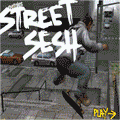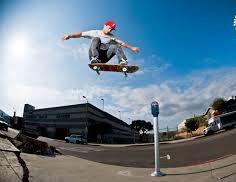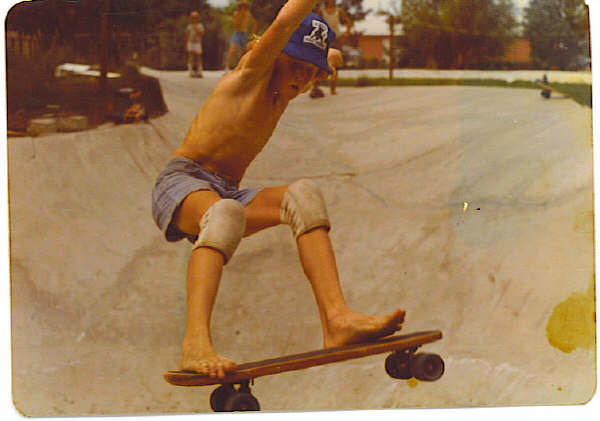|
|
All you need to know about skateboarding ! |
Do you want to know all about Skateboarding ? I'm sure that the answer on this question is YES. Then don't wait , visit this site and don't miss anything on these pages . Here you will find the most amazing facts , stories and more about the great , fun and extreme sport - skateboarding. If you want to read more ... Read About Skate Parks.
|
| |
About Skateboarding
A skateboard is a type of sports equipment used primarily for the activity of skateboarding. It usually consists of a specially designed maplewood board combined with a polyurethane coating used for making smoother slides and stronger durability.A skateboard is propelled by pushing with one foot forward while the other stays on the board, or by pumping one's legs in structures such as a pool or half pipe .
|
Skateboarding is an action sport which involves riding and performing tricks using a skateboard. Skateboarding can also be considered a recreational activity, an art form, a job, or a method of transportation. Skateboarding has been shaped and influenced by many skateboarders throughout the years. A 2002 report found that there were 18.5 million skateboarders in the world. 85% of skateboarders polled who had used a board in the last year were under the age of 18, and 74% were male.
There are so many skateboarders today it is crazy , recent study shows that there are over 12 million people world wide that skateboard and a third of those people are under the age of 18. That is one good sport and a lot of people must love something about the sport of skateboarding and its extremness. |
|
Skateboarding may be just a sport to some but to the people that actually love the sport it is a lifestyle. In past it was just a piece of wood with wheels and now the modern skateboard that we are using is made from all kinds of different things like fiberglass and the wheels are not just wheels anymore they are made from polyurethane and other materials. So if you though that skateboards were still being made like they were back then you need to go look at what is being made now.
Skateboarding is both a recreational and competitive sport that combines roller-skating, surfing, and skiing. Although skateboards are available in a broad range of designs and materials, all of them feature a board, or deck, an axle assembly, or truck, and four wheels. Highly skilled skateboarders can perform stunts involving sitting, kneeling, turning, spinning, jumping over obstacles, moving backward and forward, and balancing on one or two hands. |
Ad |
| |
The History of Skateboarding
Period between 1940-1960
Skateboarding was probably born sometime in the late 1940s or early 1950s when surfers in California wanted something to surf when the waves were flat. No one knows who made the first board, rather, it seems that several people came up with similar ideas at around the same time. These first skateboarders started with wooden boxes or boards with roller skate wheels attached to the bottom. The boxes turned into planks, and eventually companies were producing decks of pressed layers of wood -- similar to the skateboard decks of today. During this time, skateboarding was seen as something to do for fun besides surfing, and was therefore often referred to as "Sidewalk Surfing".
The growth of the sport during this period can also be seen in sales figures for Makaha, which quoted $10 million worth of board sales between 1963 and 1965 (Weyland, 2002:28). Yet by 1966 the sales had dropped significantly (ibid) and Skateboarder Magazine had stopped publication. The popularity of skateboarding dropped and remained low until the early 1970s.
The 1970s
The improvement in traction and performance was so immense that from the wheel's release in 1972 the popularity of skateboarding started to rise rapidly again, causing companies to invest more in product development. Nasworthy commissioned artist Jim Evans to do a series of paintings promoting Cadillac Wheels, they were featured as ads and posters in the resurrected Skateborder magazine, and proved immensely popular in promoting the new style of skateboarding. |
As the equipment became more maneuverable, the decks started to get wider, reaching widths of 10 inches (250 mm) and over, thus giving the skateboarder even more control. Banana board is a term used to describe skateboards that were skinny, flexible, with ribs on the underside for structural support and very popular during the mid-1970s. They were available in myriad colors, bright yellow probably being the most memorable, hence the name. Skateboarders, most notably Ty Page, Bruce Logan, Bobby Piercy, Kevin Reed, and the Z-Boys (so-called because of their local Zephyr surf shop) started to skate the vertical walls of swimming pools that were left empty in the 1976 California drought. This started the vert trend in skateboarding. With increased control, vert skaters could skate faster and perform more dangerous tricks, such as slash grinds and frontside/backside airs.
|
|
| This caused liability concerns and increased insurance costs to skatepark owners, and the development of improved knee pads that had a hard sliding cap and strong strapping proved to be too-little-too-late. During this era, the "freestyle" movement in skateboarding began to splinter off and develop into a much more specialized discipline, characterized by the development of a wide assortment of flat-ground tricks. |
The 1980s
This period was fueled by skateboard companies that were run by skateboarders. The focus was initially on vert ramp skateboarding. However, a majority of people who skateboarded during this period never rode vert ramps. |
Because most people could not afford to build vert ramps or did not have access to nearby ramps. These days the popularity of street skating is increased and freestyle skating remained healthy throughout this period with pioneers such as Rodney Mullen inventing many of the basic tricks of modern street skating such as the Impossible and the kickflip. The influence freestyle had on street skating became apparent during the mid-eighties, but street skating was still performed on wide vert boards with short noses, slide rails, and large soft wheels. Skateboarding, however, evolved quickly in the late 1980s to accommodate the street skater. Since few skateparks were available to skaters at this time, street skating pushed skaters to seek out shopping centers and public and private property as their "spot" to skate.
The 1990s to the present
Most boards are about 7¼ to 8 inches wide and 30 to 32 inches long. The wheels are made of an extremely hard polyurethane, with hardness approximately 99a. The wheel sizes are relatively small so that the boards are lighter, and the wheel's inertia is overcome quicker, thus making tricks more manageable. Board styles have changed dramatically since the 1970s but have remained mostly alike since the mid 1990s. The contemporary shape of the skateboard is derived from the freestyle boards of the 1980s with a largely symmetrical shape and relatively narrow width. This form had become standard by the mid '90s. |
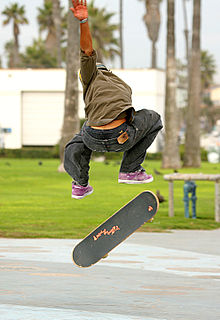 This is how skateboarding looks today, awesome!
This is how skateboarding looks today, awesome! |
| |
Trick Skating
Tricks are the best thing about skateboarding ... The simplest one is ollie - just jump with your skateboard !With the evolution of skateparks and ramp skating, the skateboard began to change. Early skate tricks had consisted mainly of two-dimensional freestyle manoeuvres like riding on only two wheels ("wheelie" or "manual"), spinning only on the back wheels (a "pivot"), high jumping over a bar and landing on the board again, also known as a "hippie jump", long jumping from one board to another, (often over small barrels or fearless teenagers), or slalom. |
Another popular trick was the Bertlemann slide, named after Larry Bertelemann's surfing manoeuvres.
In 1976, skateboarding was transformed by the invention of the ollie by Alan "Ollie" Gelfand. It remained largely a unique Florida trick until the summer of 1978, when Gelfand made his first visit to California. Gelfand and his revolutionary maneuvers caught the attention of the West Coast skaters and the media where it began to spread worldwide. The ollie was adapted to flat ground by Rodney Mullen in 1982. Mullen also invented the "Magic Flip," which was later renamed the kickflip, as well many other tricks including, the 360 kickflip, which is a 360 pop shove it and a kickflip in the same motion. The flat ground ollie allowed skateboarders to perform tricks in mid-air without any more equipment than the skateboard itself, it has formed the basis of many street skating tricks. A recent development in the world of trick skating is the 1080, which was first ever landed by Tom Schaar in 2012.
If you want to read more ... Read About Skate Parks. |
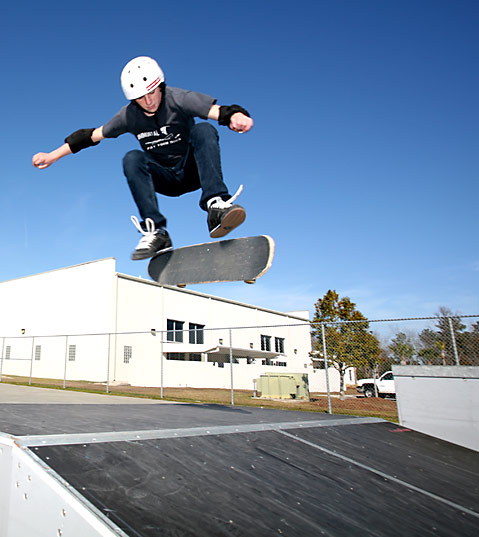 Kickflip
Kickflip |
| |
| © . All Data presented on this page are strictly informative . MySkateboardingGames.com has no responsibility for any inconvenience that may arise if you use this information for non informative purposes (quizzes , prize games , betting etc .) . |
| |
|



